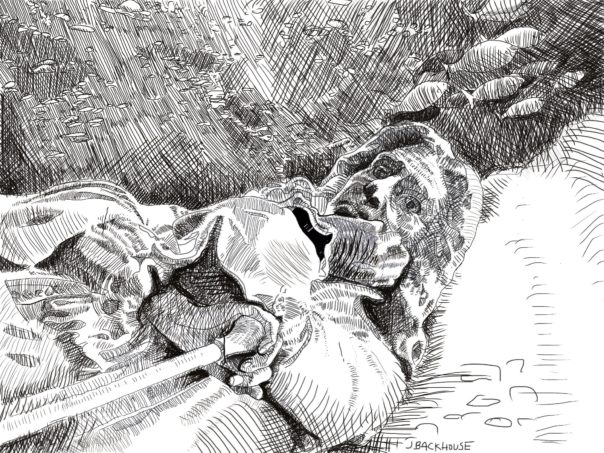
Picture: courtesy of J. Backhouse
Shielded by their Royal Charter of 1552, the Society of Merchant Venturers (SMV) helped shape Bristol’s past and present, but will they shape the city’s future? Regarded today as the doyen of Bristol’s charities, this undemocratic, unelected club for wealthy business(men), is guardian to a goodly proportion of Bristol’s schools and university, presenting itself as an innocuous force for good. Others are convinced that the SMV are outdated and outmoded.
The Charter was granted at the time of a power vacuum, filling the void between Church and State that Henry VIII had created with his Reformation during the sixteenth century. Setting the template for future years, the Society’s first Governor was Sebastian Cabot, one of the earliest Bristolians to be involved in the African slave trade. Bristol’s SMV were made up of merchants and adventurers that in the early seventeenth century included American colonisers Thomas Guy and Martin Pring. Other leading Bristol merchants like Robert Aldworth traded with Spain and Portugal; Aldworth was the first to set-up a Sugar Refinery in Bristol in 1612.
By investing in early exploration and colonisation the SMV interests greatly expanded throughout the 17th Century. This led to plantations in the Caribbean and the Americas. To protect their overseas tobacco trade the SMV suppressed local growers and to augment their use of forced and bonded labour in the plantations, the Society campaigned to become involved in the transatlantic slave trade. SMV Master, Charles Clark, stated in 1920:
For nearly forty years the Bristol merchants engaged in a truceless warfare as champions of free trade with Africa against the would-be monopolists of London [Royal African Company or RAC].
In 1698, the wishes of the SMV were granted by Parliament and the African trade was opened up to merchants across the country. Within ten years of the overthrow of the RAC monopoly, Bristol’s African slave-trading fleet had grown to almost 60 vessels.
Many dynastic families in Bristol were members of the SMV, including several generations of Colstons. In 1709 Edward Colston chose the Society to act as his trustees with the aim of perpetuating his memory – looking after ‘his’ school and other endowments. Other families, like the Eltons, first prospered in the Brass industry and then banking in the 1750s. Many SMV members used the Corporation (modern day Bristol City Council) to climb the power ladder, Alderman, Mayor, Sheriff, MP etc.
In 1789, to protect themselves against the growing campaign for abolition, Bristol’s merchant elite established an influential committee to defend their interests in the slave trade. Made-up primarily from members of the Bristol Corporation and the SMV, they became the New West India Society. Their petitions, originally signed by 11 ‘African Merchants’, 23 ‘West Indian Merchants and Planters’ and 34 ‘manufacturers’, helped delay abolition of the slave trade until 1807, and full emancipation until 1838.
Amongst them was Sir James Laroche (SMV Master 1782) responsible for over 132 slave trading voyages and Thomas Daniel (SMV Warden 1789, Master 1805 and 1834) who received the equivalent of over a £100 million in compensation money for the enslaved people he ‘owned’. SMV historian Francis Greenacre described Daniel as: “…one of the most powerful defenders of slavery”.
Defoe’s ‘[Bristol] corporation-tyranny’ was as true in the 1820s as it was in the 1720s. Over 100 years of election violence, bribery, lack of representation, blackmail, and corruption led directly to the turbulent 1830s where reform of Parliament, Municipal Corporations and finally Emancipation held sway. It is clear Bristol’s merchant elite used the Corporation, SMV and Bristol Dock Company to further their own economic and political interests – whilst the Colston Societies were employed to enhance their popularity and influence through charity and patronage.
The first academic study of Bristol slavery and the slave trade was written by Professor C. M. MacInnes. His 1939 Gateway to Empire, is full of imperialist exhortations, attempts to portray the British slave-system as being the most humane and characterising the slave owners as ‘kind despots’ and ‘pillars of society’. The book was dedicated to the SMVs: “… whose fellowship has played so notable a part in the history of the Empire.”
This stance persisted in 2006. On the eve of the two hundredth anniversary of the abolition of the slave trade, D’Arcy Parkes, SMV spokesman stated:
We all regret that the slave trade happened. Slavery was a trade in which all of Bristol was involved in, but we believe an apology is totally meaningless.
This ‘we were all in it together’ position was another deliberate attempt to try and lessen the important role the SMV had played historically in slavery and to make all Bristolians culpable; something which was patently untrue.
In 2018 SMV member Francis Greenacre, was involved in an attempt to sanitise the history of Edward Colston during the statue plaque controversy, which the Society subsequently stated was “inappropriate”. Though this was only after Colston’s statue was dumped in the docks. In response to the latter the Mayor announced a new (as yet undefined) ‘History Commission’ – despite the city already having a well documented past. Is this yet another smokescreen for inaction? Bristol desperately needs both change, ridding itself of the influence of unfair and undemocratic business(mens)’ clubs, and an international memorial to the victims of enslavement…
This article written by Mark Steeds first appeared in The Bristol Cable, Issue 23.
For a more detailed history of the Merchant Venturers and the transatlantic slave trade see Mark’s recent book From Wulftsan to Colston.




